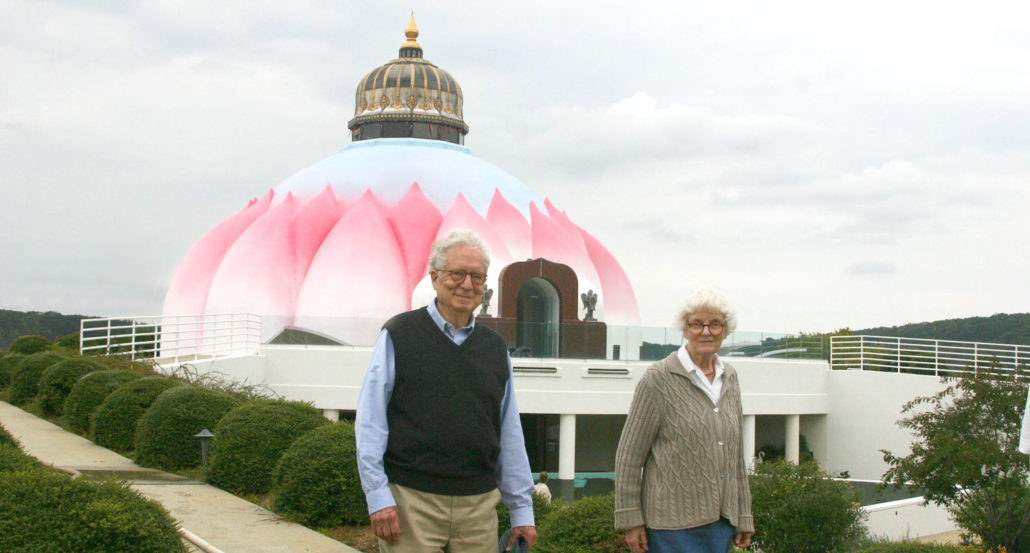By Robert Venturi, FAIA, Int. FRIBA
In October 2006 renowned architects Robert Venturi and Denise Scott Brown joined their son, Jim Venturi, for a visit to Yogaville to attend the celebrations of the 40th anniversary of Integral Yoga and the 20th anniversary of LOTUS. On the occasion, we invited Mr. Venturi to comment upon the design of LOTUS and his experiences that weekend. He graciously agreed.

One of the many books by Robert Venturi and Denise Scott Brown that have become classic reading for architecture students.
The Light Of Truth Universal Shrine (LOTUS) is a very significant religious building of the 20th century as its architecture engages space, structure and color to create a symbolic whole. Its colorful lotus petals work not only as symbolic ornament but also as structure. Its varieties of scales via the quality of its details work so the architecture is effective as seen from close-up and from a distance. It has supreme quality within its context—that of its natural environment among fields and forests, with its fountain as Genevan Jet d’Eau—and as it connects elegantly with the Chidambaram Shrine and Kailash Temple via its axial relationship with them.
Its interior space exudes religious aura, engaging structure and lighting where there is central space with a central element as a shaft of light. This light corresponds to the row of piers which is a central element in the Gothic nave of the Church of the Jacobins in Toulouse. The central element within LOTUS, however, is not structural but rather is aesthetically symbolic, a ray of light within a glass tube.
The interior religious space is also determined by other elements of light, those of neon ribs defining a domed space that is otherwise dark. No exterior light penetrates LOTUS, except for the two doors related to the geometric exterior axis. These doors work as exceptions to make the general darkness more special and religious because of its symbolism. Here, we find an interior made holy largely via its expression derived from technical lighting systems of our time.
In the lower-level space, exhibitions display explicit information integrated within the architectural form of the building as a whole. This information acknowledges and pertains specifically to the many religious ideals that are integral to LOTUS.
LOTUS is a unique architecture of the 20th century that acknowledges symbolism, emits information, and engages color within its aesthetic. It employs elements that are every day as neon and spiritual in their expression.
As architects, we (Robert Venturi and Denise Scott Brown) very much appreciate what the architect, Jim McCabe, and builders of this great structure have achieved in actualizing the vision of Sri Swami Satchidananda.
Postscript:
Four Beautiful Days at Yogaville

I enjoyed the juxtapositions of rock and roll danced by former hippies, their reminiscences of Sri Swami Satchidananda and the deep spiritual significance of his teaching engaging love and peace within interfaith diversity. I adored hearing about his kindly wit and meeting a beautiful social, vegetarian and religious community—in a lovely natural setting. Here is an example of the kind of complexity and contradiction I have written about, par excellence.
Robert Venturi and Denise Scott Brown were interviewed along with world-class colleagues.Robert Venturi and Denise Scott Brown were interviewed along with world-class colleagues.Robert Venturi, FAIA, Int. FRIBA, and Denise Scott Brown, RIBA, are two of America’s most esteemed contemporary architects. Harvard University Press referred to Mr. Venturi and Ms. Scott Brown’s contributions a having “ influenced architects worldwide for nearly half a century.” In addition to founding and serving as principals for the greatly respected architectural firm of Venturi, Scott Brown and Associates, this husband and wife team have received widespread attention as theorists, writers and educators. Their work has been recognized with over 150 honors, including the National Medal of Arts (a U.S. Presidential Award).
